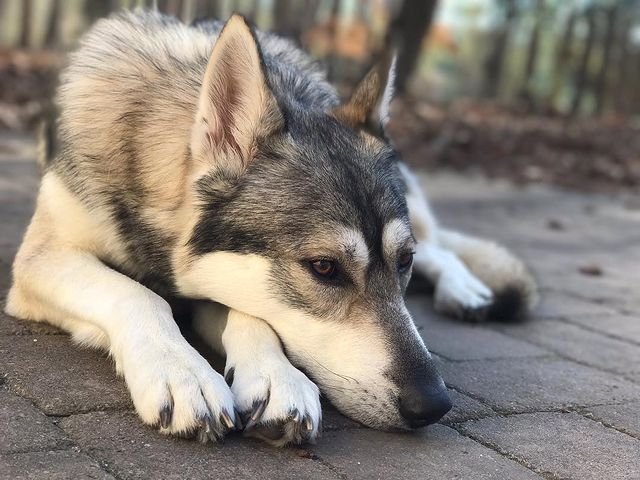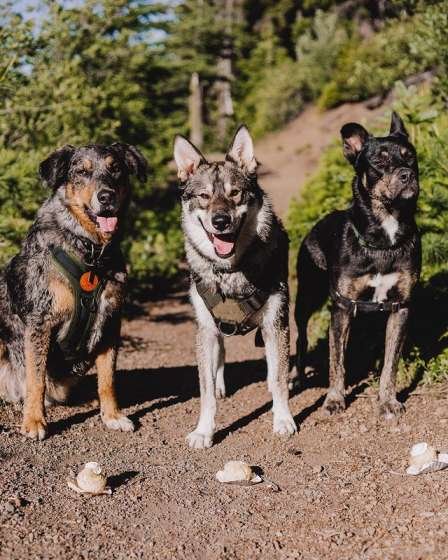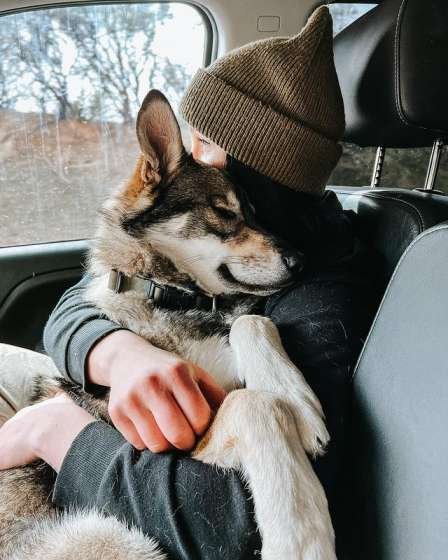The Tamaskan is a highly energetic family dog with a wolf-like appearance. It is birthed by a crossbreed of the Siberian Husky, Malamute, and Samoyed breeds. While Tams are known to be intelligent companions, they can exhibit some stubborn tendencies, making them unsuitable for first-time dog owners.
Nevertheless, the breed’s athletic features and size make it a perfect working dog, if trained properly. Do you wish to be the proud owner of this uncommon breed? This article lets you in on the most accurate information about the Tamaskan’s care, health, and personality.

Tamaskan Facts and Figures Summary
| TRAITS | DETAILS |
|---|---|
| Name | Tamaskan |
| Other names | Tamaskan Husky, British Timber, Utonagan |
| Parents | Siberian Husky, Alaskan Malamute & Samoyed |
| Life span | 14-15 years |
| Height | 24-28 inches (Females) 25-29 inches (Males) |
| Weight | 50 and 84 pounds (Females) 66 and 99 pounds (Males) |
| Personality | Intelligent, Loyal, Independent |
| Temperament | Affectionate, Playful, Occasionally Quarrelsome |
| Shedding Level | Low to Medium |
| Puppy cost | $1700-$2500 |
What is a Tamaskan Mix?
Interestingly, the Tamaskan breed has recent origins and gained popularity after appearing in movies as a CGI depiction of wolves. The name “Tamaska” is from an Algonquin language meaning “strong wolf”. Across Europe and North America where Tamaskans are mostly found, they are typically called Utonagan, Tamaskan Husky or British Timber.

Considering that this dog type only surfaced about two decades ago, not too much of its history is lost. The development of Tamaskans date back to the 1980s when breeders imported the Siberian Husky and other Arctic breeds from North America to England. In turn, they crossed the Husky with other wolf-like English cross-breeds like the Alaskan Malamute, Samoyed, and the German Shepherd.
The products of this experiment were firstly called Harrison Wolfdogs, after Edwina Harrison, the leader of the breeding group. Later, the breed was known as the Northern Inuit, a designation that caused problems and led members of the breeding program to split. After this split, a faction of the breeders called the dogs Utonagan.
Lynn Sharkley, who is commonly credited with discovering the Tamaskan, visited Finland and crossbred the Utonagan with Polar Speed huskies. The result was a strong wolf-looking dog fitting for movies and work. As such, it is generally agreed that the Tamaskan Mix came predominantly from the Alaskan Malamute, Siberian Husky and Samoyed.
However, through the cross-breed process, Tamaskans are found to have DNA and features of German Shepherds and Polar Speed dogs. The Kennel Club of the USA and the American Rare Breed Association (ARBA) officially recognize the Tamaskan breed. However, the breed is yet to be registered by the American Kennel Club or the FCI.
Tamaskan Health & Appearance at a Glance
Given that this dog breed has about three to four parents, its features are drawn across its ancestry. Tamaskans are large and athletic-looking dogs having a generally similar size to the German Shepherd. Just like its parent breeds, the Utonagan also has a thick coat as well as a straight, bushy tail.

Besides, it typically comes in three color variants, namely wolf gray, black gray, and red gray. One would naturally expect the Tamaskan Husky to have blue eyes like its Husky ancestors. On the contrary, they tend to mostly have brown or hazel eyes.
Build, Height and Weight
Tamaskans are a huge, long-legged breed with a long snout and erect, pointed ears that characterizes a wolf. This breed’s untamed traits and big size give it a commanding, protective aura. They also possess quite a number of traditional Husky characteristics, like masks, saddles, and straight bushy tails.
The males are considerably bigger than the females, weighing between 66 and 99 pounds and standing between 25 and 29 inches tall. Females are between 50 and 84 pounds and typically measure between 24 to 27 inches in height.
Colors and Coat
One of the striking features of the Tamaskan is its double-layered coat which is similar to that of Huskies and Malamutes. Its outside coat has medium length and features a shaggy, coarse feel while the undercoat is largely smooth and dense.
Additionally, the undercoat is multicolored, having various hues of gray, brown, black and white, very similar to Timble wolves. On the flip side, the breed’s overcoat comes in three different shades of wolf gray, black gray, and red gray. The eyes of a Tamaskan are shaped like almonds and are mostly yellow, amber, or brown in color.
Life Expectancy and Possible Health Issues
In comparison to other dogs with its size, the Tamaskan breed enjoys a rather lengthy existence. The breed’s average life expectancy is about 14 to 15 years. This puts Tamaskans on the longer end of the big dog lifetime spectrum, making them ideal companion dogs. This lifespan, when combined with their loving characteristics, makes them staunch buddies for a very long period.
Cryptorchidism, epilepsy, hip dysplasia, and degenerative myelopathy are some of the health challenges that this breed is susceptible to. Frequent tests and health care can help to timeously discover and address any potential health challenges.
Tamaskan Personality Traits
As a result of the mixture of all its bloodlines, the dog has a pleasant demeanor. They are very energetic and hardworking, making them thrive in situations that require them to contribute. At the same time, they effectively balance an outgoing personality with a solemn outlook when needed. However, if your Tamaskan gets withdrawn for long, do not encourage such behavior.
Tamaskans make excellent friends and can be ideal family dogs. They are also brilliant and admirable, especially when they are given the opportunity to socialize early on. Quite importantly, the dog is prone to separation anxiety, so ensure to be around them frequently.
Tamaskan Temperament and Instincts
The Tamaskan Dog, despite its wild appearance, is essentially a docile breed. They make great family pets or companions to single dwellers, thanks to their extremely affectionate nature. . However, Tamaskans detest being left alone for an extended amount of time. When this happens, they may express their separation anxiety by destroying objects around them.
With a Utonagan as your furry friend, you are assured of a dedicated and loyal friend. Nevertheless, you owe a duty to lead the Tamaskan and display some level of fierce supervision to keep your dog in check. Considering everything, it is safe to assume that this breed enjoys being around people and gets along well with children.
How to Care for a Tamaskan?
Tamaskans are generally considered a low-maintenance breed. Particularly, they blow their coat only twice every year and shed very moderately, depending on your location’s climate. They do, however, require proper care in addition to their continuous training. The following are some important elements to consider when caring for your Tamaskan.

Grooming and Shedding
Due to the Tamaskan’s double-layered coat, you may want to pay attention to the shedding of different layers. For instance, the undercoat sheds and produces mountains of fluff during the fall and spring seasons. In such seasons, they require limited attention, typically restricted to brushing the coat on a regular basis.
Surprisingly, Tamaskans do not require an excessive amount of grooming. In fact, just like cats, they can bathe themselves. They should only require particular attention if you notice that they are shedding more than usual. And even then, a wash and a nice brush may help loosen everything up.
If their nails aren’t already clipped from their activities, make sure to keep them trimmed. It’s also a good idea to clean out their ears every now and then. It’s worth noting that they’re not hypoallergenic.
Diet and Feeding
Due to the nature of the Tamaskan dog as a high-energy working breed, it requires a commercial dog food diet that is both nutrient and calorie-dense. To achieve the greatest results, feed the breed with a high-quality diet that includes an active or working breed formula.
You should also select a kibble that is appropriate for the age of your pet. Naturally, the dog’s preference will change as it gets older, so it’s critical to pick a meal that’s appropriate for his age.
If you have any questions or concerns about your dog’s nutrition, you should always check with your veterinarian. While dog food companies and pet bloggers provide helpful feeding guidelines, all dogs are unique, and only a veterinarian is equipped to establish your dog’s precise nutritional requirements.
Activity and Exercise Requirements
Knowing that the Tamaskan wolf-dog was bred to be a working dog can help you determine how much exercise they will require. As the day progresses, you can anticipate taking them for several walks and runs, and they’ll need plenty of time off the leash to explore and have fun.
If you do not intend to employ your dog for work, it is critical that you involve them in other activities that will allow them to use their intellect. Enrolling them in agility training and canine sports is a fantastic option because it will let them demonstrate their inbred abilities.
How to Train a Tamaskan?
This breed responds well to training due to its high intelligence. It requires early socialization and training to keep its enthusiasm under control. Considering that these dogs might be stubborn, you’ll need to keep a firm and consistent hand in training and provide the dog with strong leadership.
These pups may be too much effort for a newbie or first-time dog owners, therefore it’s better not to pick this breed if you don’t have prior training and ownership experience. It will also take patience and determination to successfully train a Tamaskan, and not all dog owners are capable of doing so.
It’s best to approach training this breed with confidence and use positive reinforcement techniques. Instead of being harsh or aggressive, use treats and praise as a motivator. Aversive training for Tamaskans is not only cruel, but it is also entirely ineffective.
Known Tamaskan Health Problems
The Tamaskan is a relatively young breed, so information on congenital health issues is sparse. Notwithstanding, the hybrid comes from a combination of breeds that are noted for their impressive health. As a result, you may expect the Tamaskan dog to be in good health for the most part.
Some of the most common diseases associated with Tamaskans include cryptorchidism, epilepsy, hip dysplasia, and degenerative myelopathy. As always, regular examinations with a veterinarian are essential (particularly as the dog gets older) to ensure that any potential health issues are discovered and treated as soon as possible.
Daily Routine for a Happy Tamaskan
As soon as your Tamaskan wakes up, it needs to go potty. Every day, the dog requires a lot of physical exercises. As a result, you should encourage three daily 15-minute walks. You should also schedule around 10 minutes of physical activity twice a day.
This breed should be fed before each round of physical activity. Puppy food should be given to them after their morning stroll, at lunchtime, and after sunset. The dog should be able to go to the potty after each meal. Also, be sure to provide periods of instruction and rest for your puppy in between walks.
Is a Tamaskan the Right Dog for You?
This pooch breed is perfect as a family dog because they offer companionship. They also fit as working dogs. However, you must be ready to meet the dog’s emotional needs considering their susceptibility to separation anxiety. Also, training this breed requires confidence and it is most preferable that a person with prior experience of training dogs gets it. If you’re ready to meet the training and activity requirements, then there’s no reason to not have this breed.
Should you buy or adopt a Tamaskan?
This rarity of this breed explains the difficulty encountered in buying it and its high price. This also makes adoption a more realistic approach for anyone interested in having this breed. However, it is advised that the dog should be checked for genetic conditions prior to adoption.
FAQs about the Tamaskan Cross-Breed
Is Tamaskans a breed of wolves?
No, they are not. Tamaskans were bred to look like wolves, yet they do not have any wolves in their lineage. They were intentionally bred from Husky-type dogs that look like wolves, with no wild animals involved.
Does Tamaskans get along well with cats?
Tamaskan dogs get along great with cats and other pets in general, but they must be socialized with them from the time they are puppies. If a Tamaskan puppy is raised with cats and other pets, it will consider them buddies.
Is the Tamaskan breed recognized by the AKC?
Because of the breed’s thorough and selective cross-breeding program with purebred genetics, Tams are considered “designer dogs”. As a result, the breed is not recognized by the American Kennel Club (AKC).
How many Tamaskans are there in the world?
Although there are only about 400 Tamaskan dogs worldwide, growing interest has led to their spread across continental Europe, the United Kingdom, and the United States, as well as Canada and Australia.
Are Tamaskans hypoallergenic?
Tamaskans shed their fur moderately and are not hypoallergenic. So, keep this in mind before purchasing or adopting one. Besides, the dogs are simple to groom and require you to brush their hair as infrequently as once every week.
Do Tamaskans exhibit aggressive traits?
This pooch breed may show aggressive tendencies against strangers and pets if they do not receive sufficient training. They have strong protective instincts as well as a high prey drive, this can be curbed by consistent training.
What should you feed a Tamaskan?
You should consider giving your Tamaskan dry food, kibble, canned food, or broth. These meals offer comprehensive nutrients to your adult dog. Also, ensure that your furry friend’s meals are grain-free and easy to digest. Rice, potatoes, and cooked chicken are perfect examples of human food for a Tamaskan.
